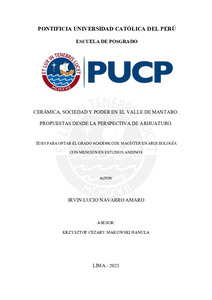Cerámica, sociedad y poder en el valle de Mantaro. propuestas desde la perspectiva de Arhuaturo
Abstract
El valle del Mantaro, uno de los más extensos de los Andes centrales, ha sido
investigado por la arqueología desde hace algunas décadas. El medular interés que motivó
estos trabajos fue conocer el desarrollo cultural de esta cuenca durante los distintos
periodos prehispánicos. En los años que se viene desarrollando la arqueología en este
valle, se han expuesto diversos planteamientos que han aportado en la discusión sobre el
tema en mención. Lo propuesto hasta la fecha se ha sustentado sobre los datos
recolectados de diferentes partes del valle y en especial de la septentrional, siendo escasos
en estos estudios el uso de evidencias materiales del área sur. Con esta tesis, a partir del
estudio del sitio arqueológico Arhuaturo, uno de los asentamientos prehispánicos más
representativos del área austral del Mantaro, se busca estimular el debate sobre cómo en
esta cuenca fue el desarrollo cultural entre el siglo I y principios del siglo XVI. En este
trabajo se analiza la organización política y social que tuvo la población del valle del
Mantaro en sus momentos de autarquía durante el periodo pre Wari (0-800 d.C.) y en el
periodo Intermedio Tardío (1000-1460 d.C.), así como cuando fueron sometidos por los
Wari y el Tawantinsuyo. Del mismo modo, se examina el contexto político y social que
hallaron estos dos Estados andinos a su llegada al Mantaro y cómo esto repercutió en su
forma de ejercer poder y administrar este lugar. Por último, se analiza cómo las
sociedades del valle se identificaron mediante su cultural material en un contexto local y
macro-regional entre el periodo Intermedio Temprano y Horizonte Tardío. The Mantaro Valley, one of the largest in the central Andes, has been investigated
by archeology for some decades. The core interest that motivated these works was to
know the cultural development of this basin during the different pre-Hispanic periods. In
the years that archeology has been developing in this valley, various approaches have
been made that have contributed to the discussion on the subject in question. What has
been proposed to date has been supported by data collected from different parts of the
valley and especially from the northern part, the use of material evidence from the
southern area of the Mantaro being scarce in these studies. With this thesis, based on the
study of the Arhuaturo archaeological site, one of the most representative pre-Hispanic
settlements in the southern area of Mantaro, it seeks to stimulate the debate on how
cultural development in this basin was between the 1st century and the early 16th century.
This work analyzes the political and social organization that the population of the Mantaro
Valley had in their moments of autarky during the pre-Wari period (0-800 AD) and in the
Late Intermediate period (1000-1460 AD), as well as when they were subdued by the
Wari and the Tawantinsuyo. In the same way, the political and social context that these
two Andean states encountered upon their arrival in the Mantaro and how this had an
impact on their way of exercising power and administering this basin is examined.
Finally, it is analyzed how the societies of the valley were identified through their material
culture in a local and macro-regional context between the Early Intermediate period and
the Late Horizon period.
Temas
Arqueología--Perú--Junín--Mantaro, Valle
Cerámica--Perú--Junín--Mantaro, Valle
Etnología--Perú--Junín--Mantaro, Valle
Cerámica--Perú--Junín--Mantaro, Valle
Etnología--Perú--Junín--Mantaro, Valle
Para optar el título de
Magister en Arqueología con mención en Estudios Andinos
Collections
The following license files are associated with this item:






